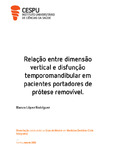| dc.contributor.advisor | CARDOSO, MÓNICA ALEXANDRA GUEDES | |
| dc.contributor.author | López Rodríguez, Blanca | |
| dc.date.accessioned | 2023-11-24T10:36:52Z | |
| dc.date.available | 2023-11-24T10:36:52Z | |
| dc.date.issued | 2023 | |
| dc.identifier.uri | http://hdl.handle.net/20.500.11816/4447 | |
| dc.description.abstract | Introdução - A DTM é um conjunto de patologias que afetam os músculos mastigatórios e/ou a ATM e estruturas adjacentes, causando dor, fraqueza muscular, estalidos articulares, limitação ou alteração do movimento da mandíbula; e a etiologia é multifatorial.
A DVO é importante para a função mastigatória e estabilidade muscular, e pode ser determinada a partir da posição muscular fisiológica de descanso. Uma reabilitação oral deve considerar a oclusão e musculatura do paciente para prevenir lesões neuromusculares, embora o sistema estomatognático tenha a capacidade de se adaptar a mudanças moderadas na DVO, alguns pacientes podem apresentar sintomas transitórios leves de DTM.
Objetivos - Realizar uma revisão sistemática integrativa para determinar se existe uma relação causal entre DTM e DVO em pacientes com prótese removível.
Metodologia - A pesquisa bibliográfica foi realizada na plataforma PubMed com um período de 13 anos de inclusão (2010-2023).
Resultados - Dos 806 artigos apenas 53 foram selecionados para avaliação. Após leitura, 11 artigos foram selecionados aplicando os critérios de inclusão e exclusão. Foram incluídos 2 artigos de pesquisa manual e 1 artigo utilizado para fundamentação teórica.
Conclusões - A perda de dentes pode contribuir para DTM e o uso de próteses dentárias removíveis pode aumentar a probabilidade do aparecimento de sinais e sintomas. O aumento da DVO até 5mm é bem suportado. Goteiras oclusais e outras formas de aumento provisório de DVO podem melhorar os sintomas de DTM antes de uma reabilitação oral definitiva. A evidência de associação entre fatores protéticos e DTM é limitada. | pt_PT |
| dc.description.abstract | Introduction - TMD is a set of pathologies that affect the masticatory muscles and/or the TMJ and adjacent structures, causing pain, muscle weakness, joint clicking, limitation or alteration of jaw movement; and the etiology is multifactorial.
The OVD is important for masticatory function and muscle stability, and can be determined from the physiological resting muscle position (RVD). An oral rehabilitation should consider the occlusion and musculature of the patient to prevent neuromuscular injuries, although the stomatognathic system has the capacity to adapt to moderate changes in the OVD, some patients may have mild transient symptoms of TMD.
Objectives - Perform an integrative systematic review to determine whether a causal relationship exists between TMJ dysfunction and OVD in patients with removable prostheses.
Methods - The bibliographical research was carried out on the PubMed platform with a period of 13 years for the inclusion of studies (2010-2023).
Results - Out of 806 articles, only 53 were selected for full-text evaluation. After reading, 11 articles were selected based on inclusion and exclusion criteria. 2 manual research articles and 1 article used for theoretical foundation were included.
Conclusion - Loss of teeth can contribute to TMD and the use of removable dentures can increase the likelihood of signs and symptoms appearing. OVD increase up to 5mm is well supported. Occlusal splints and other forms of temporary OVD augmentation may improve TMD symptoms prior to definitive oral rehabilitation. The evidence of association between prosthetic factors and TMD is limited. | pt_PT |
| dc.language.iso | por | pt_PT |
| dc.rights | info:eu-repo/semantics/openAccess | pt_PT |
| dc.subject | VERTICAL DIMENSION | pt_PT |
| dc.subject | TEMPOROMANDIBULAR DYSFUNCTION | pt_PT |
| dc.subject | CENTRIC RELATION | pt_PT |
| dc.subject | OCCLUSION | pt_PT |
| dc.title | Relação entre dimensão vertical e disfunção temporomandibular em pacientes portadores de prótese removível | pt_PT |
| dc.type | info:eu-repo/semantics/masterThesis | pt_PT |
| dc.identifier.tid | 203356780 | pt_PT |
| thesis.degree.name | Mestrado em Medicina Dentária | pt_PT |

